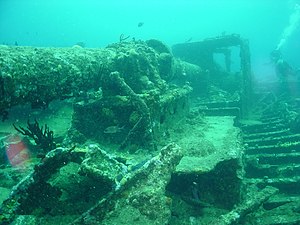RMS Rhone

The wreck of RMS Rhone
|
|
| History | |
|---|---|
|
|
|
| Name: | RMS Rhone |
| Namesake: | River Rhone |
| Owner: |
|
| Operator: |
|
| Port of registry: |
|
| Route: |
|
| Ordered: | June 1863 |
| Builder: | Millwall Iron Works |
| Launched: | 1865 |
| Maiden voyage: | 9 October 1865 |
| Out of service: | 29 October 1867 |
| Fate: | Sunk by Hurricane |
| Status: | Wreck |
| General characteristics | |
| Type: | passenger liner |
| Tonnage: | 2,738 GRT |
| Length: | 310 ft (94 m) |
| Beam: | 40 ft (12 m) |
| Installed power: | 500 NHP |
| Propulsion: | compound steam engine; screw |
| Speed: | 14 knots (26 km/h) |
| Capacity: | Passengers: 253 1st class, 30 2nd class, 30 3rd class |
| Notes: | sister ship: Douro |
RMS Rhone was a UK Royal Mail Ship owned by the Royal Mail Steam Packet Company (RMSP). She was wrecked off the coast of Salt Island in the British Virgin Islands on 29 October 1867 in a hurricane, killing 123 people. She is now a popular Caribbean wreck dive site.
RMSP ships carried mail, passengers, horses, and cargo on regular scheduled routes. Its first services had been between Southampton and the Caribbean, but in 1851 it added a new route between Southampton and Rio de Janeiro. This growing trade, and a number of ships lost at sea, created a need for new ships.
In June 1863 RMSP ordered Rhone from the Millwall Iron Works on the Isle of Dogs, London and her sister ship Douro from Caird & Company in Greenock. The pair was initially to work the Rio de Janeiro route. They were similar but not identical. Both were handsome ships, but Rhone was considered to have slightly finer lines.
At this time the Admiralty supervised Royal Mail Ship contracts. During building the Admiralty surveyor criticised Rhone's bulkheads and water tight compartments. Revisions were made, and the ship was completed to the surveyor's satisfaction.
Rhone had an iron hull, was 310 feet (94 m) long, had a 40-foot (12 m) beam and 2,738 GRT. She was a sail-steamer, rigged as a two-masted brig. Her compound steam engine developed 500 NHP and gave her a speed of 14 knots (26 km/h) on her sea trials. In her contract the ship cost £25 17s 8d per ton and her engine cost £24,500.
...
Wikipedia
